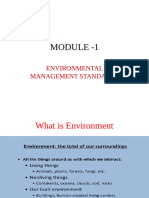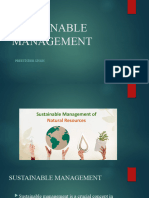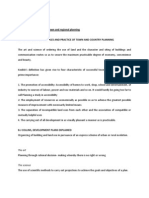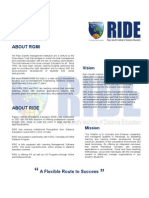Topic 5 - Prevention Measure
Topic 5 - Prevention Measure
Uploaded by
Jomari TawatCopyright:
Available Formats
Topic 5 - Prevention Measure
Topic 5 - Prevention Measure
Uploaded by
Jomari TawatCopyright
Available Formats
Share this document
Did you find this document useful?
Is this content inappropriate?
Copyright:
Available Formats
Topic 5 - Prevention Measure
Topic 5 - Prevention Measure
Uploaded by
Jomari TawatCopyright:
Available Formats
Prevention Measures
TOPIC 5
DISCLAIMER
This learning material will be used in compliance with the flexible learning approach as directed
by CHED (Commission on Higher Education) in response to the COVID-19 pandemic, that has
globally affected educational institutions. The author/s and publishers from where the contents
were derived are well acknowledged. As such the college and its faculty do not claim ownership
of all sourced information. This learning material will solely be used for instructional purposes
not for commercialization.
POLLUTION PREVENTION AND WASTE MINIMIZATION
Pollution Prevention – is any practice that reduces, eliminates, or prevents pollution at its
source.
- reducing the amount of pollution produced means less waste to control, treat or dispose
of.
- less pollution means less hazards posed to public health and the environment.
SPECIFIC POLLUTION PREVENTION APPROACHES
Agricultural Sector
o reducing the use of water and chemical inputs
o adoption of less environmentally harmful pesticides or cultivation of crop strains
with natural resistance to pests.
o protection of sensitive areas
Industrial Sector
o modifying a production process to produce less waste
o using non-toxic or less toxic chemicals as cleaners, degreasers and other
maintenance chemicals
o implementing water and energy conservation practices
Home and Schools
o using reusable water bottles instead of throw-aways
o automatically turning off lights when not in use
o automatically turning off fans and other electrical equipment when not in use
o switching to green cleaners
WHY IS POLLUTION PREVENTION IMPORTANT?
- pollution prevention reduces both financial costs (waste management and cleanup) and
environmental costs (health problems and environmental damage)
- pollution prevention protects the environment by conserving and protecting natural
resources strengthening economic growth through more efficient production in industry
and less need for households, business and communities to handle waste
Waste Minimization – is the reduction in the quantity of hazardous wastes achieved through a
conscientious application of innovative or alternative procedures.
- avoid mixing hazardous and non-hazardous wastes; avoid contaminating glass ware
- rotate chemical stock to keep chemicals from becoming outdated
- order smallest container of material necessary for use
- review experimental protocol to assure that chemical usage is minimized
- take care when weighing and transferring chemicals in order to minimize spills and
additional wastes generated during spill clean up.
CONSERVATION MEASURES
Conservation – is the wise management and utilization of natural renewable resources in a
sustainable manner to ensure the maintenance of biodiversity.
- the goal of conservation is sustainable use and management of an economically
important natural resource so that people can continue using the resource.
Ways in Environmental conservation:
1. turning off lights and other home appliances when not is used
2. throwing trash in the trashcans according to the waste
3. switching to non plastic water bottles and bags
4. driving less, cycling more
5. planting more trees
6. finally, reduce, reuse and recycle.
SUSTAINABILITY
- is meeting the needs of the present generation without compromising the ability of future
generations to meet their own needs.
3 Dimensions of Sustainability
1. Environmental sustainability – includes issues of environmental stewardship, natural
resources, climate change, renewable energy and related fields. Seeks to promote the
responsible use of natural resources to ensure a healthy life and longevity for future
generations.
2. Social sustainability – addresses the ability of a social system to function over time.
Incorporates issues of human rights, corporate responsibility and resource access.
Focuses on relating individuals behavior to attitudes, and well being to create
sustainable social systems.
3. Economic sustainability – encourages the responsible use of resource. Considers
both environmental and social impacts of operational behavior. Focuses on increasing
profitability from investing in long term sustainable practices
Funding for Sustainability Initiatives
1. EPA – Funds Sustainability research and projects
2. Department of Energy – offers funding or private sector sustainability
3. NCTCOG(North Central Taxes Council of Government) – sustainable development
funding program for private/public transportation improvement
4. Coca Cola – offers 52 sustainability grants to countries around the world.
You might also like
- VAC III Zero Waste PracticesDocument21 pagesVAC III Zero Waste PracticesTushar JorraNo ratings yet
- Unit VI Environment Responsibility of CitizenDocument12 pagesUnit VI Environment Responsibility of CitizenMusom BBANo ratings yet
- WASTE MANAGEMENTmicrobiology AssignemetDocument19 pagesWASTE MANAGEMENTmicrobiology Assignemetdakshsharma21082002No ratings yet
- Human Conservation Efforts and Sustainable Development ActionsDocument2 pagesHuman Conservation Efforts and Sustainable Development ActionsAlvin Villanueva Jr.No ratings yet
- Epm Module-1 Ppt-Environmental Management StandardsDocument39 pagesEpm Module-1 Ppt-Environmental Management StandardsSathish YANo ratings yet
- Waste ManagementDocument6 pagesWaste Managementridaangupta240No ratings yet
- PPTDocument29 pagesPPTabhiram0777ramNo ratings yet
- SustainabilityDocument4 pagesSustainabilitymiyaganesh5No ratings yet
- Jashan SSTDocument10 pagesJashan SSTnopeanonymous28No ratings yet
- Prevent Production of Hazardous and Polluting Materials Rather Than Producing Them andDocument4 pagesPrevent Production of Hazardous and Polluting Materials Rather Than Producing Them andLee Jia HuiNo ratings yet
- InglesDocument1 pageInglesMARCO ANTONIO RODRIGUEZ PANTOJANo ratings yet
- Sustainable Agriculture & IndustrializationDocument11 pagesSustainable Agriculture & IndustrializationnikhilNo ratings yet
- Solid Waste ManagementDocument8 pagesSolid Waste ManagementMay ThansinNo ratings yet
- SnehalDocument9 pagesSnehalShantanu KarandeNo ratings yet
- Cwats Module 5Document30 pagesCwats Module 5Angelica Dancalan ArenasNo ratings yet
- Group 5, Wastes Management HeheDocument24 pagesGroup 5, Wastes Management Hehenazankeijprado2305No ratings yet
- Waste Management Sustainable Solutions for a Cleaner FutureDocument10 pagesWaste Management Sustainable Solutions for a Cleaner Futurekowshik.annavarapu2006No ratings yet
- Actividad 2. InglishDocument6 pagesActividad 2. InglishselenegonzalezfcoNo ratings yet
- Module 1 PDFDocument30 pagesModule 1 PDFGirish PushparajNo ratings yet
- SWM Report AnujDocument13 pagesSWM Report AnujgodxdhruvNo ratings yet
- Assignment - 2evsDocument4 pagesAssignment - 2evsSyed Ahmad MohsinNo ratings yet
- green skillDocument4 pagesgreen skillrocking9163No ratings yet
- TQM 2Document3 pagesTQM 2Just a Night owl that Has insomniaNo ratings yet
- All NotesDocument5 pagesAll Notesjudith ignatiusNo ratings yet
- Waste Management and Pollution ControlDocument18 pagesWaste Management and Pollution Controltrippic2396No ratings yet
- Pollution Prevention Opportunities For Dairy Industries PDFDocument2 pagesPollution Prevention Opportunities For Dairy Industries PDFManoj KantiNo ratings yet
- Unit 2Document13 pagesUnit 2Md. SunmunNo ratings yet
- Ecological Waste Management System - 20240421 - 113047 - 0000Document43 pagesEcological Waste Management System - 20240421 - 113047 - 0000Jeanny DesucatanNo ratings yet
- Chapter 16 Green ChemistryDocument32 pagesChapter 16 Green ChemistryMaitha AlhammadiNo ratings yet
- EcoInnovators_About the Competition.docxDocument3 pagesEcoInnovators_About the Competition.docxSavio GasperNo ratings yet
- Save The EnvironmentDocument2 pagesSave The Environmentshardulchaughule10No ratings yet
- BE Final Presentation-2024Document43 pagesBE Final Presentation-2024mba202201No ratings yet
- NullDocument13 pagesNullgodxdhruvNo ratings yet
- Ecosystem 2Document3 pagesEcosystem 2sahuparas005No ratings yet
- Solid Waste ManagementDocument19 pagesSolid Waste ManagementSuneetha ChittineniNo ratings yet
- Chapter 3Document1 pageChapter 3kcta.escobanez.uiNo ratings yet
- Ecological Waste Management System. Group 3Document9 pagesEcological Waste Management System. Group 3Jeanny DesucatanNo ratings yet
- Jigyasu Helping CompanyDocument2 pagesJigyasu Helping CompanyMitul DeoNo ratings yet
- Sustainable ManagementDocument10 pagesSustainable Managementpreetindersingh75279No ratings yet
- Environmental ScienceDocument7 pagesEnvironmental ScienceHusnain AhmedNo ratings yet
- Protecting The EnvironmentDocument2 pagesProtecting The EnvironmentgioninebunugamingNo ratings yet
- Waste Disposal and Effluent TreatmentDocument4 pagesWaste Disposal and Effluent TreatmentEnaye MajiriNo ratings yet
- Environmental StudiesDocument15 pagesEnvironmental StudiesYOHAN FERNANDONo ratings yet
- Ecodesign PDFDocument2 pagesEcodesign PDFitamarcostNo ratings yet
- Sustainable Design: Ar. Asia JabeemDocument32 pagesSustainable Design: Ar. Asia JabeemKhiZra ShahZadNo ratings yet
- Sustainable Hanger IndiaDocument77 pagesSustainable Hanger IndiaNishantFogaatNo ratings yet
- Inbound 8261522388841047684Document18 pagesInbound 8261522388841047684Clark ToledoNo ratings yet
- advanceDocument2 pagesadvanceldcNo ratings yet
- Introduction to Green Living : A Course for Sustainable LifestylesFrom EverandIntroduction to Green Living : A Course for Sustainable LifestylesNo ratings yet
- Energia SostenibleDocument11 pagesEnergia Sostenibleitzep britoNo ratings yet
- Sustainability: Ethical and Social Responsibility DimensionsDocument19 pagesSustainability: Ethical and Social Responsibility Dimensionssixew14782No ratings yet
- Slide Presentation by Lesley Allen Kabigting For The Role of Economics in Environmental ManagementDocument35 pagesSlide Presentation by Lesley Allen Kabigting For The Role of Economics in Environmental ManagementLee K.No ratings yet
- NSTP PresentationDocument11 pagesNSTP Presentationpanangcadjhonemart2No ratings yet
- Evs Project Anushka 11thDocument22 pagesEvs Project Anushka 11thJating JamkhandiNo ratings yet
- GARCIA MariannAngelDocument6 pagesGARCIA MariannAngelmariann0313angelNo ratings yet
- How To Reduce PollutionDocument2 pagesHow To Reduce PollutionSumaiyaNo ratings yet
- Environmental Impact AssessmentDocument31 pagesEnvironmental Impact AssessmentDeep PatelNo ratings yet
- 9 Waste Management BSBADocument7 pages9 Waste Management BSBAurbanoryan519No ratings yet
- NOTESDocument2 pagesNOTESHassin HassinNo ratings yet
- AREA 1 - Farm Toolsmachineriesequipment Operations and MaintenanceDocument37 pagesAREA 1 - Farm Toolsmachineriesequipment Operations and MaintenanceJomari TawatNo ratings yet
- AREA 2 - Nursery Establishment and Management PDFDocument22 pagesAREA 2 - Nursery Establishment and Management PDFJomari TawatNo ratings yet
- LM in NATSCI Unit 1 MidtermDocument20 pagesLM in NATSCI Unit 1 MidtermJomari TawatNo ratings yet
- Area 3 - Agronomic and Horticultural ProductionDocument11 pagesArea 3 - Agronomic and Horticultural ProductionJomari TawatNo ratings yet
- UNIT 1: Environmental Science: NATSCI (Natural Resources and Environmental ManagementDocument137 pagesUNIT 1: Environmental Science: NATSCI (Natural Resources and Environmental ManagementJomari TawatNo ratings yet
- Topic 2 - Biomes and Biodiversity (AutoRecovered)Document12 pagesTopic 2 - Biomes and Biodiversity (AutoRecovered)Jomari TawatNo ratings yet
- LM in NATSCI Unit 1 MidtermDocument20 pagesLM in NATSCI Unit 1 MidtermJomari TawatNo ratings yet
- Iodine DeficienDocument5 pagesIodine DeficienJomari TawatNo ratings yet
- Raise Organic Pig NewDocument94 pagesRaise Organic Pig NewJomari Tawat100% (1)
- Chapther 2 ThesesDocument15 pagesChapther 2 ThesesJomari TawatNo ratings yet
- Chapter 4 (AZOLLA)Document8 pagesChapter 4 (AZOLLA)Jomari TawatNo ratings yet
- Calicut Civil Engineering B.techDocument155 pagesCalicut Civil Engineering B.techJinu Madhavan100% (1)
- Extension EducationDocument62 pagesExtension EducationsandhyaRanimohantyNo ratings yet
- Textbook of Environment Studies For Undergraduate Courses - Erach Bharucha PDFDocument260 pagesTextbook of Environment Studies For Undergraduate Courses - Erach Bharucha PDFPari Athouba100% (2)
- Work-Life Balance and Its Effect On Employee Productivity: A Case Study of GIMPA 1.0Document11 pagesWork-Life Balance and Its Effect On Employee Productivity: A Case Study of GIMPA 1.0Elijah AppiaheneNo ratings yet
- CMMS Best Practices Study - ReliabilitywebDocument49 pagesCMMS Best Practices Study - Reliabilitywebmelator100% (2)
- EconomicsDocument181 pagesEconomicsChanpreet KaurNo ratings yet
- Lecture 1Document6 pagesLecture 1Siti Nadirah Shuhaimi100% (1)
- Fauquier County Rural Lands Plan DraftDocument41 pagesFauquier County Rural Lands Plan DraftFauquier NowNo ratings yet
- Introduction To Operations Management (Session 1)Document22 pagesIntroduction To Operations Management (Session 1)Sahil GuptaNo ratings yet
- Business EconomicsDocument34 pagesBusiness EconomicsShamimiZrmnNo ratings yet
- St. Mary'S Convent Senior Secondary School, Faridabad Class Viii Holiday Homework (2021-22) Social Studies InstructionsDocument3 pagesSt. Mary'S Convent Senior Secondary School, Faridabad Class Viii Holiday Homework (2021-22) Social Studies InstructionsIndia MagicNo ratings yet
- Comparative Management ModelsDocument3 pagesComparative Management ModelsVictor Temitope Owokole67% (3)
- PGPEMDocument2 pagesPGPEMRgmi-ride PuneNo ratings yet
- ch.4 TestDocument31 pagesch.4 Testmarisa corderoNo ratings yet
- Nonprofit Cost AnalysisDocument21 pagesNonprofit Cost AnalysisiguhwiNo ratings yet
- A Report On DominoDocument10 pagesA Report On DominoTeman MantenNo ratings yet
- PMACST - Richard Lipsey PresentationDocument24 pagesPMACST - Richard Lipsey PresentationGary StairsNo ratings yet
- THE Tourism Development DilemmaDocument11 pagesTHE Tourism Development Dilemmaalexrascanu100% (2)
- Internal Assessment 91227Document8 pagesInternal Assessment 91227Mary26297No ratings yet
- 76effectiveness of The Sacco Governance Model - KusccoDocument10 pages76effectiveness of The Sacco Governance Model - KusccoRam SrivastavaNo ratings yet
- Reviewer Chapter 2Document2 pagesReviewer Chapter 2Angel GarciaNo ratings yet
- Case Study of The Management and Organisation of ADIDASDocument14 pagesCase Study of The Management and Organisation of ADIDASShela JanuartiNo ratings yet
- Alternative Conceptions of Sustainability in A Business ContextDocument11 pagesAlternative Conceptions of Sustainability in A Business ContextNuriaNo ratings yet
- Sustainable Tourism A Case of Destination Competitiveness in South AsiaDocument7 pagesSustainable Tourism A Case of Destination Competitiveness in South AsiaklarisaNo ratings yet
- Community-Based Tourism in Boloc-Boloc, Barili, Cebu, Philippines: A Stakeholders ApproachDocument8 pagesCommunity-Based Tourism in Boloc-Boloc, Barili, Cebu, Philippines: A Stakeholders ApproachPsychology and Education: A Multidisciplinary JournalNo ratings yet
- Methodology For Prototyping Integrated and Organi-Wageningen University and Research 138521Document9 pagesMethodology For Prototyping Integrated and Organi-Wageningen University and Research 138521NeetaNo ratings yet
- Functions of Public FinanceDocument6 pagesFunctions of Public FinanceJefferson KagiriNo ratings yet
- Before The FloodDocument2 pagesBefore The FloodAngelika CotejoNo ratings yet
- Class 8th - Chapter - Resources - Geography (One Shot) 2Document20 pagesClass 8th - Chapter - Resources - Geography (One Shot) 2chiranjib sarkarNo ratings yet
- APWorldI SUMMERASSIGNMENTWKSHTDocument5 pagesAPWorldI SUMMERASSIGNMENTWKSHTJack JacksonNo ratings yet




































































































